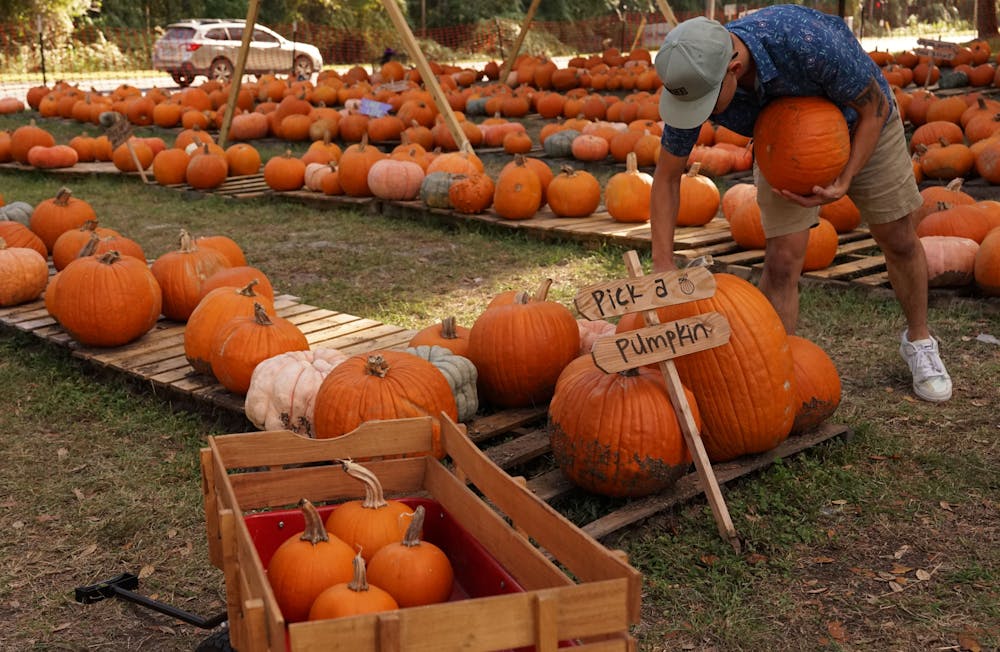Under a canopy of string lights off Northwest 39th Avenue rest thousands of pumpkins — eight semi-truck loads, to be exact — anxiously waiting to be chosen and taken home by their forever family.
Complete with photo booths, a bounce house and famous loaves of pumpkin bread, the pumpkin patch is part of the Gainesville Church of God’s fundraiser to feed hungry children across Alachua County and through Central and South America — a tradition the church named “Buy a Pumpkin, Feed a Child.”
This is the 11th year the patch has been open. Not a dollar of its profits go back to the church, said pumpkin patch volunteer Chris Chrisopulos.
“Our goal is to bless the people here as well as bless the people who are in need,” he said.
For several Alachua County churches, including this one, the month of October signals the beginning of one of the most anticipated fundraisers of the year: pumpkin patches. Across the country, Christian churches, particularly of the Methodist denomination, use the fall season as an opportunity to raise money by selling pumpkins.
Not-so-spooky patches
Although some denominations of Christianity frown upon Halloween — citing its origins as a Pagan celebration — the United Methodist Church has no official stance on the holiday. Each congregation can choose whether or how to engage with spooky activities, including pumpkin patches.
For the Alachua Pumpkin Patch, pumpkin-selling is more correlated with the fall season than with Halloween, despite running only until Halloween day, volunteer Wendy Seale said. Signs across the patch read “Welcome to Autumn” and “Happy Fall.” Aside from the pumpkins themselves, there’s no mention of Halloween in sight.
The patch, which is run by Alachua Methodist Church and located on U.S. 441 near Interstate 75, has been selling pumpkins for 23 years. It features a hay maze, tractor rides and thousands of pumpkins laid on pallets across an expansive yard lent to the church by a local homeowner.
The Alachua Pumpkin Patch’s proceeds go toward the church’s annual mission trip. The location of the trip changes from year to year, and the church hasn’t decided if it’ll go out of state or do community service within Alachua County.
Although the patch, which brought in between $15,000 and $16,000 in profit last year, doesn’t entirely pay off the costs for the mission, it does cover a portion, Seale said.
The best part for Seale, a 53-year-old Alachua resident, is watching families come back to the patch year after year, she said.
Rachel Hill, a 34-year-old Alachua resident, and her three children have been coming to the pumpkin patch for eight years. Throughout October, the family looks forward to coming to the pumpkin patch while driving past it every day, she said.
“When you come here, you can feel that everybody is really happy and that they've enjoyed it for some time,” she said.
Although she isn’t a member of the church, Hill said she’s never considered switching patches because the patch volunteers make her feel like family.
“They made me feel great from the very beginning,” she said. “It's the people. You go to a place, and the people are so kind, and they make you want to come back.”
Where do the pumpkins come from?
No two pumpkins and no two patches are the same. Spherical orange pumpkins, green striped gourds and bright white squashes create a rainbow assortment of choices for customers to go home with their dream pumpkin. Although they look different, many were grown in the same place.
For 194 pumpkin patches in Florida, the holy grail of pumpkin sourcing is Pumpkin Patch Fundraisers, also known as Pumpkins USA. Of the patches the company provides for, about 98% are churches, and the majority are Methodist churches, spokesperson and co-owner John Hamby said.
Hamby’s parents started Pumpkin Patch Fundraisers in 1974 with three acres of pumpkins and a deal to sell them with one church. Today, it grows 1,200 acres of pumpkins and partners with more than 1,000 organizations across the country.
The company is based out of Farmington, New Mexico, on part of the Navajo reservation. The family business prides itself on employing more than 700 Navajo people during harvest season, according to its website.
Rather than selling pumpkins directly to churches and other nonprofit organizations, Pumpkin Patch Fundraisers ship pumpkins by the truckload on consignment, meaning there are no upfront costs. In return, a portion — about two-thirds, by one church volunteer’s estimate — of pumpkin revenue is sent back as payment to the company.
Churches don’t need to pay for any pumpkins they didn’t sell, but they are responsible for finding a place to dispose of the leftovers.
This year, the Southwest United Methodist Church partnered with two nearby methodist churches to split the profits of their joint pumpkin patch, sourced through Pumpkin Patch Fundraisers. The church usually stays in contact with local farmers to feed leftover pumpkins to livestock, volunteer Tom Beukelman said.
The church expects to sell about $10,000 worth of pumpkins by the time it closes Oct. 31, Beukelman said. In the spirit of Halloween, he hoped a special visitor would come that night, referencing the 1966 animation “It’s the Great Pumpkin, Charlie Brown.”
“Hopefully, at the end of that day and evening, the Great Pumpkin will visit,” he said.
Contact Alissa Gary at agary@alligator.org. Follow her on Twitter @AlissaGary1.

Alissa is a sophomore journalism major and University Editor at The Alligator. She has previously covered student government, university administration and K-12 education. In her free time, she enjoys showing photos of her cats to strangers.





